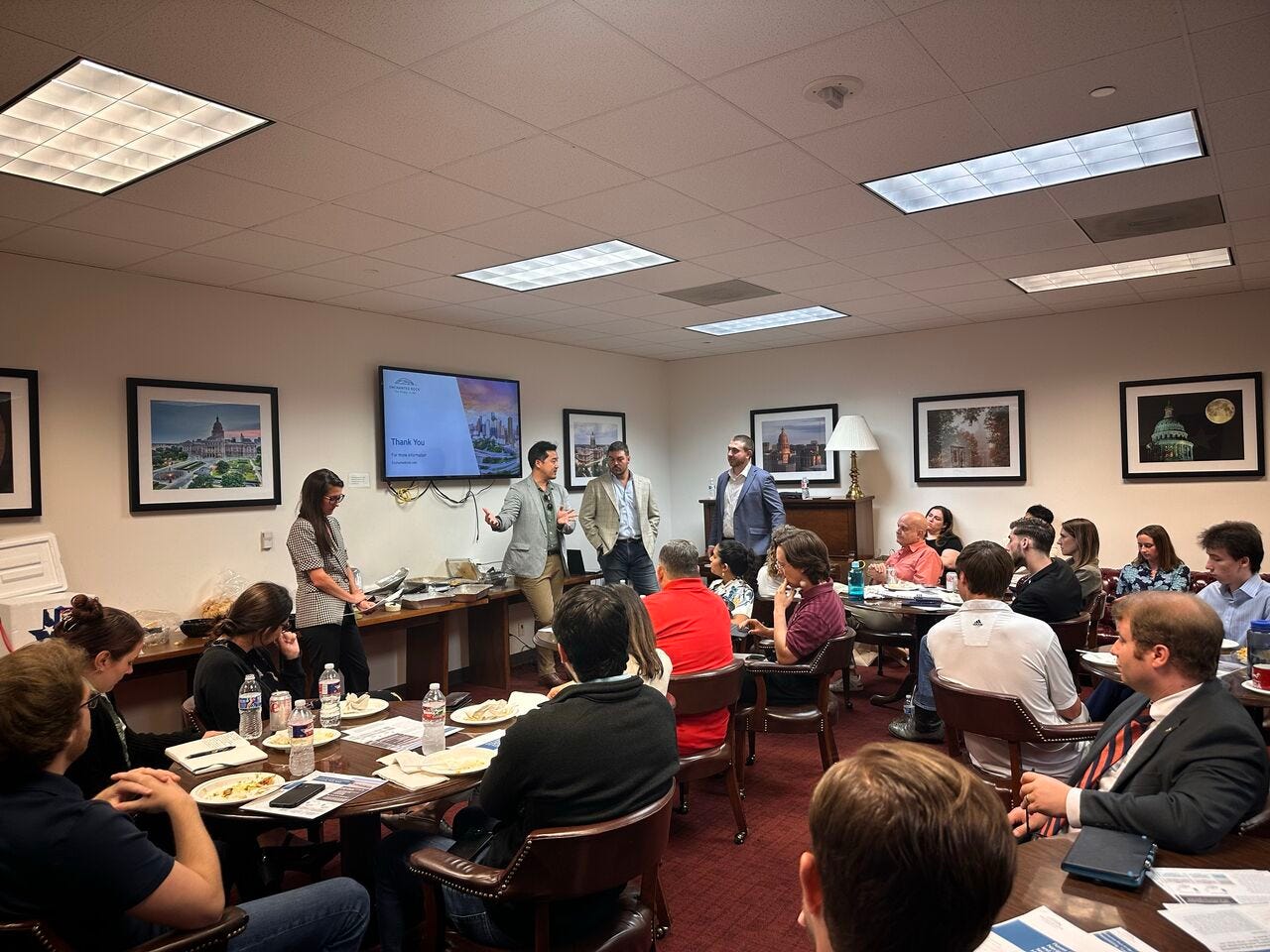Prosperity is energy intensive and nine out of ten.
Those are the two bumper stickers I wanted to leave with the Texas legislative staff that I met with earlier this week. Enchanted Rock, a microgrid company, hosted a luncheon for staff members working for the Texas legislature. They graciously brought me along to talk about the Abundance Institute’s work on electricity markets and enabling an energy-abundant future.
Prosperity is energy-intensive
Wealthy countries use a lot of energy. This chart shows the correlation between energy use and economic well-being. The chart shows that there aren’t wealthy and low-energy countries. There are plenty of poor and low-energy countries on the chart. To continue growing our economy and improving lives, we need policies that support energy abundance.

Enabling energy abundance in practice means removing barriers to emerging technologies. Human development can be seen as a story of harnessing energy, from the Stone Age, where we used simple tools, to the Iron Age, where we refined materials for better tools. Today's world is wealthy because of its ability to harness and employ more energy and to do it more efficiently. Policy needs to continue and support this progress by updating rules and regulations to unlock resources like nuclear power and microgrids.
Nine out of ten
Texas has abundant and cheap electricity almost all of the time. In fact, the Independent Market Monitor’s 2023 report shows that in 9 out of 10 hours, electricity is between 0 and $50 per Megawatt.

What about the other hour? That 10 percent of the time when power is expensive? Policymakers can find a powerful tool by enabling flexibility. Imagine a new way to connect to the electrical grid. The conditions are straightforward. The system operator gives a data center a quick connection to the electrical grid. In return, they get to use power when prices are low. But when the grid is stressed, that data center has to turn off.
Policymakers could call these interconnection agreements “reliability interconnections” to emphasize that they prioritize critical needs, such as hospitals and vulnerable populations, during that last hour. In the other nine hours, reliability interconnections offer data centers reliable energy. This approach protects consumers and ensures a stable energy supply.
The central point is that grid operators can immediately give data centers 9 out of 10 hours. Data centers face extensive delays in connecting to the grid where they’re not facing potential building bans. One projection ranges from 3 to 7 years for data center interconnections. With a reliability interconnection, data centers could be guaranteed power 90 percent of the time in exchange for reduced power during peak hours. This would protect vulnerable consumers and attract new investments to Texas (or whatever jurisdiction adopts the right policies enabling flexibility).
Fundamentally, data centers are high-energy users, which does create short-run challenges. However, not all data centers must run 24/7. They can turn down in tight times. Policymakers just need to encourage data center operators to consider this flexibility option.
This conversation about flexibility just isn’t happening right now. Taking a step back, note that public commentary gets the data center opportunity backward. Reporting tends towards portraying data centers as liabilities to everyone else. The fearful story is about data centers eating the world, leaving consumers to pay higher energy bills.
Instead, data centers are assets to the grid. For example, a data center with co-located generation resources can also sell power onto the system when system prices are high. This is the core point that Brian Janous, a previous Microsoft VP of Energy and co-founder of Cloverleaf Infrastructure, makes in a recent interview:
...data centers already have batteries and generators on their sites. Those can be optimized and they can be expanded and they can be used to provide flexibility back to the grid. A lot of this is just having more of a conversation between customers and utilities. From my experience, those conversations are not happening at the level and depth they need to happen.
Flexibility is likely a short-run solution that fades out over time. In the long run, more generators will come online to take advantage of those high prices in the market. Those additional generators pull prices back down by expanding supply. The economist’s proverb here is that the cure for high prices is high prices.
The challenge for policymakers is designing a system that keeps growing to meet the energy needs of consumers and industry. That will mean building more generators over time but economizing on existing infrastructure and assets at each moment along the way to an energy-abundant future. That energy-abundant future will have fewer and fewer moments when data centers need to slow down. But it starts with flexibility today.
A flexible system enables economic growth
To make this flexible future possible, policymakers need to create systems that allow flexible interconnections. Of course, enabling innovative companies like Enchanted Rock is just the start. Half of Texas’s peaks (winter and summer) are due to residential demand. That’s a big lever to start managing peaking moments on the grid. Investments in insulation and better heating or cooling systems could also help manage costs. Those household investments will complement expansions in good, old-fashioned generators.
These two points, that energy is fundamental to civilization and that electricity is almost always plentiful, should be guiding lights. The wrong choices today could lock out advances in artificial intelligence or delay those advances by years. They could also put the brakes on perhaps the most innovative sector of the economy and slow continued economic growth. That leaves all of us poorer than a world that unlocks and enables new technologies.
The path to a prosperous and energy-abundant future starts with embracing flexibility and modernizing our regulations. We can ensure a stable and affordable energy supply by enabling innovative solutions.




